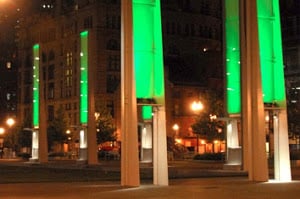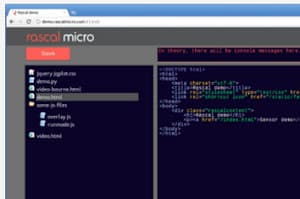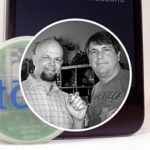I live outside of Boston and make a small computer for artists, scientists, hobbyist types who want to connect stuff to the Internet.
![]()
The Rascal is a small (about 5 cm x 10 cm), open-source computer designed for “connecting sensors, motors,and whatever else you can build to the internet”. One of the things that sets it apart from the Arduino and other microcontrollers is its built-in Ethernet connection and ability to act as its own web server (hosting its own development tools, giving you the ability to edit files directly from your browser through a web-based editor). Other features include being programmable in Python and compatibility with many existing Arduino shields.
I had a chance to talk with Rascal creator Brandon Stafford about the project and how he sees open-source hardware and the Internet of Things developing in the coming years.
A condensed and edited version of our talk is below (audio clips are also provided):
Who are you and what do you do?
My name is Brandon Stafford, I live outside of Boston and make a small computer for artists, scientists, hobbyist types who want to connect stuff to the Internet. The idea is that it is a general purpose tool that people can use to connect whatever they want to the Internet. It’s called the Rascaland I’ve started a company called Rascal Micro that consists entirely of me sitting in my house making small computers. I have worked as an engineer (mostly in renewable energy (solar, wind, etc), and some stuff involving batteries and energy storage) maybe six months out of the last year and a half and the rest of the year has been devoted to the Rascal. I actually released some beta units for sale to some testers during the summer, and I just released the first real unit with tested hardware and software about a month ago. I’ve actually now sold a bunch to friends and others who have been following along the way but more exciting I have been starting to get orders from people who I have no idea who they are, from Oxford, England, Thailand, California, etc. I still haven’t sold that many but it’s starting off and beginning to pick up speed.
Can you describe some typical users and projects the Rascal has been used for?
Examples Discussed:
– Monitoring temperature and humidity of sausages
– Anger Lights project
“…..so far people come up with weird stuff. I talk to someone new about the Rascal pretty much everyday and they will suggest something that I not just haven’t thought of it, but haven’t thought of something even near it”
Rascal Project: Boston Lightblade

Thoughts on the current state of open-source hardware and your decision to go that route?
“….the whole reason that I care about Open Hardware is I would love it if other people adopted the project and used it as the basis for variations of their own projects…… I would love it if some scientist came along and said “oh OK, I am going to use the Rascal as a starting place for my instrument and then build from there” because I think that that is something that Open Hardware 10-20 years ago we didn’t have the ability to build on each others designs nearly as efficiently as we do now.”
Any predictions on the IoT and its impact?
“…..I think the Internet of Things will also put a lot of pressure on the artificial intelligence community to really start making it work. My experience so far is that AI generally sounds very cool and I end up disappointed when I find out exactly what exists…..So I also think that it is a really hard problem, but I wouldn’t be surprised if having distributed sensor networks or small Internet nodes all over the place changes the kinds of problems that people try to solve in AI and that might make some advances.”

What are you currently working on or are most excited about?
Brandon discusses:
– Rascal as a web server
– Browser development tools
– Self serve programming tools
– Websockets:
– Web connected hardware and the disconnect between the web world and the hardware world:
“…….What’s puzzling to me is that we know that there are people out there who can make great hardware (Embedded systems, Pics, BASIC Stamp, etc ) all of these things are pretty well commodified, they have been around for along time and although the hardware is still developing it is not changing radically…….and at the same time the software engineers have pretty much solved web development or at least given us lots of great web frameworks and great ways to make interfaces using the web…… and there seems to be almost no one who can do both of those things at the same right now”
Can you speak to the long-term vision of the project?
Brandon Discusses:
– National Instruments LabVIEW and the current state of developing custom tools for scientists
– Hackerspaces and open-source components and their potential
– Educational and value shifts
– Toolkits:
Referencing Democratizing Innovation by Eric von Hippel (Free Kindle version and Creative Commons PDF)
“….talks a lot about companies trying to provide their users with toolkits rather than trying to do product development themselves and trying to guess what their users want, they try to give their users toolkits that their users can use to make the stuff that they want and that is an interesting shift.”
Shout-outs: Any sites/people/projects or books that have inspired you lately?
– Artisan’s Asylum: If you are in the Boston area.
– Web based development tools: Examples include Cloud9 and its competitors.
– CodeMirror: It is all open-source, in the Rascal, and I have really appreciated how well it has worked.
– Maker Faire: It has been great for cross-pollination, both for the people that who get to go to the event, but it also helps the other makers know that there are others out there and is one of the things that keeps me going.
– Homebrew/Development LED’s: This area hasn’t really peaked yet but could end up being really cool.
– 3d Printer space: Printrbot the $500 Kickstarter funded projects “….I hope there is a lot of competition in this space and I hope that keeps going through the roof. It’s one of those things where if you walk by one of the machines at a Makerfaire you can just see the kids whole world view shift”
Thanks for taking the time and we will be following the Rascal’s development closely.
To pick up your own Rascal visit the online store, or follow its latest development at @rascalmicro or at: http://rascalmicro.com/blog/





